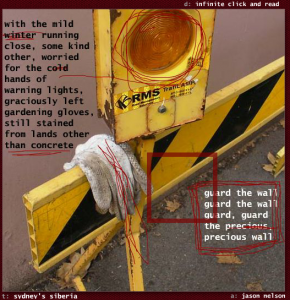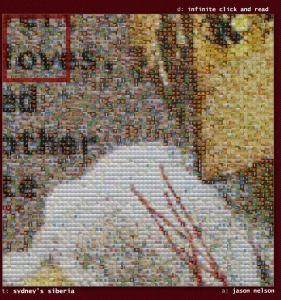We create literature and we flourish in it. In literature, our language never sets boundary for our imagination or limit for the superfluity of emotions. The power of logical and empathizing language in literature has connected each one of us closer than ever in novels, biographies, and scientific literatures. The electronic literature (e-lit), blooming since the end of last century due to the maturity of information technology, however, has opened another door to the verbal and other forms of expression of human thoughts and emotions. The emergence of such form of literature has pushed the boundary of what we would call “literature”, and it has brought us numerous benefits of reading that traditional literature cannot offer.
In contrasts to what people commonly think of e-lit as a digitized version of literature printed out on the paper, e-lit exists in its own inclusive form. Katherine Hayles commented that e-lit must be “‘digital born’, a first-generation digital object created on a computer and (usually) meant to be read on a computer” (3). So if the piece of literature on your computer can be printed out without losing any feature of the original piece, it cannot be called e-lit. Hayles, in the same passage, quoted the Electronic Literature Organization’s formulation: “work with an important literary aspect that takes advantage of the capabilities and contexts provided by the stand-along or networked computer.” (3) This explanation is particularly interesting because it not only points out that the media that present e-lit must be computer instead of papers, but the fact that the definition of e-lit cannot be pinned down metaphysically or timelessly, because it depends on the computer in our discussion. The update of information technology, which includes the hardware that produce, process and present the information, is in fact exponential. With each update of the information technology, the technological media seep into e-lit and change it. From the traditional and stick-to-the-paper-style Portable Document Format (PDF) that can be opened by Adobe Reader, to Electronic Publication (EPUB) that allows the reader to keep track of the reading speed, and from simple structured website City Stories by J. R. Carpenter, to the comprehensive interactive math learning website Mathigon, our digital reading experience has updated from both the increasing complexity of writers’ intention and the exponential tech-boosting from the technicians’ innovation.
The sudden injection of e-lite questions the never-changed definition of the word “literature”, and how e-lit sits with the traditional form of literature that we have been used to for hundreds of years. For example, think about what newspaper can do when it present news of massive deaths from a natural disaster or a war. The editor might deliberately insert words such as “heart-breaking”, “catastrophic”, “grievous” etc.; or at most a poet might write lines and lines to condole with the deaths and try to make the readers sympathetic. However, Death Moves It Forward, a website created by Jody Zellen, combines the written/pictorial representation and the vocal representation of the death news during the war (i.e. from the newspapers and the radio) with a simple Flash in which everything moves in a quick and erratic fashion. The combination of visual and auditory description impacts the reader as multiple sources of information to evoke the reader’s past experience and create a sense of chaos, which is what we usually feel when we hear death news of someone close to us. This piece of literature shakes the reader in a way that words on paper can never do, simply because it stimulates multiple senses we possess. It seems like e-lit embarks on an approach, which the traditional literature cannot substitute, to express authors’ intentionality and emotions.
Nevertheless, scholars have attempted to give out the characteristics e-lit, from which, I think, hints us in how to decide whether a piece of work is e-lit or not. Noah Wardrip-Fruin, an associated professor in the computer science department of University of California, Santa Cruz, says that “data, process, interactions, surface, and context” (Gould) are the paradigms of e-lit reading. All these paradigms of the e-lit requires the development of computer science, wherein it is the computer scientists who contribute, rather than the traditional writer. Wardrip alleged “Writers innovate on the surface level, on the reading words level – while computer scientists innovate at the process level, the algorithm level, perhaps without words at all.” (Simanowski 36) Here, the difference of e-lit and traditional literature resides not in how it affects us emotionally but the underlying creation processes. Hayles also argues that in e-lit, “human-only language and machine-readable code are performed as interpenetrating linguistic realms, thus making visible on the screenic surface a condition intrinsic to all electronic textuality, namely the intermediating dynamics between human-only languages and machine-readable code.” (21) This might hard to understand at the beginning but easy from the view point of a computer scientist. Four of the five elements, if not all of them, must be created by computer programs: data – possibly generated by the user but read and processed by codes, process – what codes do to transform input to output, interactions – how programs receive information from the reader and respond correspondingly, surface – mostly contributed from the writer but the digital representation still requiring technical support, and context – an immersive environment of reading created by “WIMP (Windows, Icons, Menus and Pointers)” (Simanowski 43) which necessarily implies the presence of the computer. Particularly, the context computer programs provide are most well utilized paradigm and differentiates the traditional literature and e-lit, as it evokes multiple senses of the reader or different functions of the same sense. For example, in City Stories, Carpenter embedded the poem describing the living environment of a “Wohngemeinschaft”1 in a drawn flat with multiple windows that the reader can click on (i.e. interaction as well) to display a particular section of the poem. This helps the reader to actually visualize the quarreling couple upstairs and the view of all the linens hung-up… The unique features of clicking everywhere to get contextualized gives the reader the opportunity to explore the literature rather than passively receive all the information from the author.
Then what this particular experience – e-lit provides us with something that traditional literature does not – tell us, is captivating. The lengthy history of literature, associated mostly, if not only, with human language, modestly salutes the incredible capacity of human language that captures our imagination and emotion; but it has finally reached its limitation, or even its impossibility, achievable by electronic literature. The fact that e-lit echoes more emotions in the reader by evoking their other senses implies the imperfection of our language because there is a part of us that it cannot reach, but a song or an image or a video or a particular smell can easily capture. True that e-lit is created by machine language and simplistic axioms, but its effects, somehow possibly, recalls a part of us that cannot be reduced to language or, what really is humanity.
Footnote:
1. Wohngemeinschaft: apartment-sharing-community
Work cited:
Gould, Amanda. “A Bibliographic Overview of Electronic Literature.” Electronic Literature Directory. Web. 28 Oct. 2014.
Hayles, Katherine. Electronic Literature: New Horizons for the Literary. Notre Dame, Ind.: U of Notre Dame, 2008. Print.
Simanowski, Roberto and Jörgen Schäfer. Reading Moving Letters: Digital Literature in Research and Teaching : A Handbook. Ed. Peter Genddlla. Bielefeld: Transcript Verlag ;, 2010. Print.



